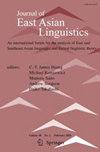历时性OT的约束重排序:南岛语的二进制脚和单词最小现象
IF 0.5
3区 文学
0 LANGUAGE & LINGUISTICS
引用次数: 0
摘要
南岛语的马来-波利尼西亚语分支的语言表现出一系列的声音变化,这些变化似乎都是由倒数第二个音节中的弱读音引起的。这些变化是最后一个音节开始的双生,在三个或更多音节的单词中删除倒数第二个元音,以及仅在开放的倒数第二个音节中将弱读音变为完整的元音。这些变化被分析为漂移的产物,即子语言的变化是由原语言的某些特性引起的。在这种情况下,有人认为在原始南岛语和原始马来-波利尼西亚语中,弱读音是一个零莫拉音的元音,这些变化为一个单词增加了一个莫拉音,否则这个单词就会包含一个退化的单莫拉音脚。观察到的变化随后被分析为历时最优性理论模型中约束提升的产物,据此约束随时间的移动可以解释历史上的声音变化。以马来-波利尼西亚语为例,研究表明,促进二元足约束(Ft-Bin)可以解释所有三种已证实的弱读音触发的声音变化。本文章由计算机程序翻译,如有差异,请以英文原文为准。

Constraint reranking in diachronic OT: binary-feet and word-minimum phenomena in Austronesian
Abstract Languages throughout the Malayo-Polynesian branch of Austronesian exhibit a range of sound changes which all appear to be triggered by the presence of a schwa in an open penultimate syllable. These changes are gemination of the final-syllable onset, deletion of penultimate schwa in three-or-more syllable words, and the shift of schwa to a full vowel in open penultimate syllables only. The changes are analyzed as a product of drift, whereby changes in daughter languages are motivated by some property of the proto-language. In this case, it is argued that schwa was a zero-mora vowel in Proto-Austronesian and Proto-Malayo-Polynesian, and that these changes worked to add a mora to a word which would otherwise contain a degenerate single-mora foot. The observed changes are then analyzed as a product of constraint promotion modeled in Diachronic Optimality Theory, whereby constraint movement over time may explain historical sound change. In the case of Malayo-Polynesian, it is shown that the promotion of the Binary Foot constraint ( Ft-Bin) can explain all three of the attested schwa-triggered sound changes.
求助全文
通过发布文献求助,成功后即可免费获取论文全文。
去求助
来源期刊

Journal of East Asian Linguistics
Multiple-
CiteScore
0.90
自引率
0.00%
发文量
13
期刊介绍:
The study of East Asian languages, especially of Chinese, Japanese and Korean, has existed for a long time as a field, as demonstrated by the existence of programs in most institutions of higher learning and research that include these languages as a major component. Speakers of these three languages have shared a great deal of linguistic heritage during the development of their languages through cultural contacts, in addition to possible genealogical linkage. These languages accordingly possess various common features. Another important factor that ties them together as a field is that they have shared a common tradition of linguistic scholarship, a tradition that distinguishes itself from the study of western languages. Against this tradition, much recent work has approached these languages from a broader perspective beyond the area, considering them within contexts of general theoretical research, bringing new lights to old problems in the area and contributing to current issues in linguistic theory. But there continues to be good reason for scholars working in this approach to hold a special interest in each other''s work. Especially with the amount of most recent theoretical work on these languages, the field of theoretical East Asian linguistics has been fast growing. The purpose of the Journal of East Asian Linguistics is to provide a common forum for such scholarly activities, and to foster further growth that will allow the field to benefit more from linguistic theory of today, and enable the languages to play a more important role in shaping linguistic theory of tomorrow.
 求助内容:
求助内容: 应助结果提醒方式:
应助结果提醒方式:


